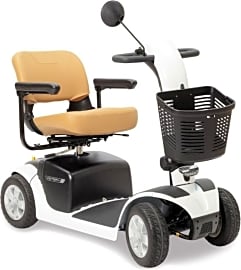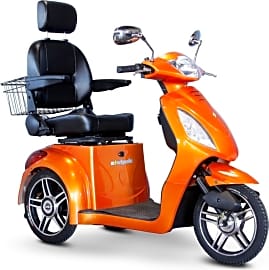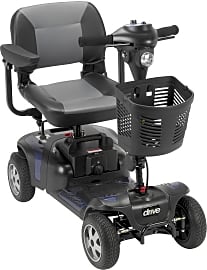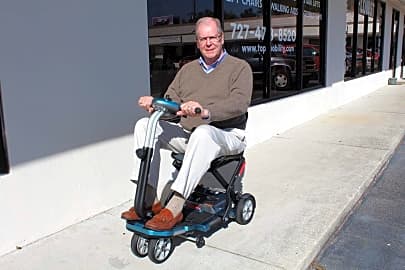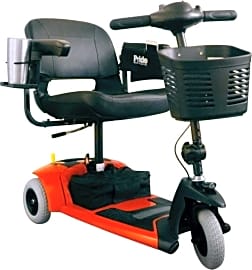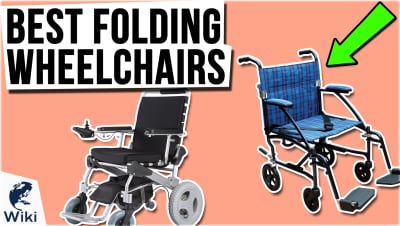The 8 Best Power Scooters

This wiki has been updated 43 times since it was first published in April of 2015. Those with limited mobility can enjoy a new lease on life with one of these power scooters. Available in a variety of colors and designs, our selection includes models with powerful electric motors, decent top speeds, long-range rechargeable batteries, adjustable seats and armrests, and durable tires for a smooth ride indoors and out. Many even break down for transportation and storage. When users buy our independently chosen editorial recommendations, we may earn commissions to help fund the Wiki.
Editor's Notes
June 25, 2021:
We thinned out a couple of models that were basically rebrands of others we recommend, but overall, there's been little change made to our rankings. The Golden Technologies BuzzAround remains the most robust, although the Pride Mobility Victory 10 is right there with it and also sports a more understated design. If you do want something flashy, consider the retro-styled E-Wheels EW-36. We also like the EV Rider Travel for a variety of tight situations because of its superior maneuverability.
March 27, 2020:
Just because you need a little assistance to get around, that doesn't mean you can't be comfortable and in control of your movements. And if you're so inclined, there's even room to have a little fun with a scooter, as well, so long as you understand the potential dangers and drawbacks. Take the E-Wheels EW-36, with its 18 MPH top speed, for example. Now, municipalities that have put restrictions on commercial e-scooters have put caps on their speeds at around 14 MPH, meaning your grandmother could potentially ourace a blazing millennial on her way to the corner drug store. That said, those restrictions are there for safety reasons, and if you're at all worried about the level of control you or a loved one might have over their scooter's speed, getting such a fast model might be a hazard. Fortunately, though, that model and some others — like the Pride Mobility Victory 10 — come in bright enough colors to increase their visibility on the road.
Speed has another important correlation, as well, and that's battery life. If you want to spend a whole day in Central Park with the family, you'll need a scooter that can last for eight to 12 hours on a single charge. A slow scooter will ask less of its battery than a speedy one, so you should be able to go for longer, even if it slows the group down a little.
Beyond those crucial features, we scrutinized things like seat comfort, storage capacity, ease of transportation, and durability in creating our ranking, which led us to remove the Smart Scoot from this iteration of the list, as its construction left something to be desired. Its replacement, the Drive Medical Cobra GT4, has some of the best steering around, as well as a trio of headlights to illuminate the path ahead.
A Brief History Of Power Scooters
Since 2000, manufacturers have worked to improve the curb appeal of powered scooters, designing sleeker hulls that borrow cues from cars and motorcycles.
Because they are similar in design and function, power scooters share a common history with wheelchairs.
This history dates back to the 6th century B.C.E., when the first records of wheeled furniture appear in China and Greece.
In China, devices similar to wheelbarrows were used to ferry both heavy objects and people. It wasn't until about 525 C.E. that the first wheeled chairs purpose-built for moving people were constructed. Still, these were likely used merely for transporting the wealthy, not those with disabilities.
The first chair intended for solo use by the disabled was invented by paraplegic German watchmaker Stephan Farffler. This three-wheeled carriage was similar to modern tricycles, with one important distinction: it could be propelled by the arms of the user. Farffler's invention is regarded as a precursor to both the tricycle and the bicycle, as well as today's power scooter.
Like some power scooters, the rolling chairs introduced in 1887 on the Atlantic City boardwalk were popular with tourists. These chairs were intended to serve the disabled, but they became a luxury service for vacationing members of the upper class, who employed servants to push them along the boardwalk.
The first modern wheelchair was designed in 1933 by engineers Harry Jennings and Herbert Everest. Everest sought a reliable and portable wheelchair after damaging his spine in a mining accident, and joined forces with Jennings to make it happen. Today, the Everest and Jennings company is among the largest manufacturers of wheelchairs.
Sears expanded on the Everest and Jennings design in 1954, introducing a primitive version of the power scooter that they called an electric wheelchair. This battery-powered scooter had three wheels, similar to Farffler's self-propelled tricycle, and a large seat like modern scooter models. Despite its innovative qualities, the Sears scooter was a commercial flop.
With advances in battery capacity and the development of lighter weight components, power scooters became more reliable in the late 20th century. Since 2000, manufacturers have worked to improve the curb appeal of powered scooters, designing sleeker hulls that borrow cues from cars and motorcycles.
These improvements inspired more and more owners to venture outside the home with their scooters. This led to legislation in many countries defining where and how scooters could be operated.
Pros And Cons Of Power Scooters
While they're not right for everyone — particularly those lacking the strength and dexterity to steer — power scooters can change the lives of people with mobility issues.
These scooters are a valuable alternative to traditional, self-propelled wheelchairs for individuals without the stamina or arm flexibility to manually roll themselves. The swiveling seats of many electric scooters are also generally regarded as superior to the stationary seats and folding foot rests of most wheelchairs. Scooters are also typically more affordable than electric wheelchairs.
Scooters are also typically more affordable than electric wheelchairs.
Mobility scooters are often used by individuals suffering from conditions affecting the whole body, like obesity, arthritis, heart disease, and lung problems. For these people, scooters can be appealing simply because they do not look like wheelchairs.
The distinct design of scooters is not without its disadvantages. Most scooters require upright posture and upper body mobility for steering and movement. They also lack the head, leg, and arm support of wheelchairs. Because most models are designed to be mounted from the standing position, scooters can also be challenging to transfer to from a bed or chair.
Owing to their length, power scooters have a significantly wider turning radius than wheelchairs, which can hamper movement and preclude the use of certain facilities designed for wheelchair access.
There is also some concern among health care professionals that power scooters may do more harm than good for those who might, in the absence of a scooter, attempt to move on their own. Particularly in older people, a sedentary lifestyle can be dangerous, according to research.
What Is A Power Scooter?
Though they have a common history, power scooters are distinct from electric wheelchairs in many ways.
Unlike electric wheelchairs, power scooters feature a seat over as many as five wheels, boast a swiveling seat, and typically have handlebars for steering.
Heavy duty rear-wheel variations can even support those weighing 500 pounds or more.
The average scooter can reach speeds as great as seven mph, and rear-wheel drive models can support riders weighing up to 350 pounds. Heavy duty rear-wheel variations can even support those weighing 500 pounds or more.
The center steering column on most scooters — also called a tiller — features forward and reverse, as well as speed controls. In many models, the tiller also includes switches for lights and turn signals, as well as a speed limiter. A panel of instruments on the tiller indicates battery power and sometimes speed, depending on the model.
Front-wheel drive models are often smaller, and intended primarily for indoor use. In addition to supporting more weight, rear-wheel designs are more likely to be suitable for outdoor operation.
The range of modern power scooters breaks down into several categories. Travel scooters are easy to take apart and reassemble, and are a popular choice for frequent vacationers. Heavy scooters are intended for use in difficult outdoor terrain, and can rival all-terrain vehicles in their ruggedness. The popular mid-range scooter is used in a variety of settings, both indoors and outside, and is right for most consumers. Finally, there are the plodding, heavier models found in many grocery stores. These are intended to carry a single passenger and their groceries, and little else.


